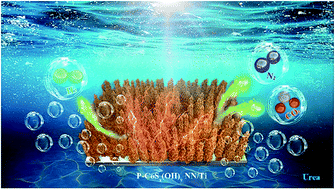Porous and amorphous cobalt hydroxysulfide core–shell nanoneedles on Ti-mesh as a bifunctional electrocatalyst for energy-efficient hydrogen production via urea electrolysis†
Abstract
Hydrogen production via water electrolysis is a sustainable and free approach to meet our energy needs, but the anodic oxygen evolution reaction (OER) has a high overpotential. In contrast, urea electrolysis can achieve higher energy conversion efficiency and has the prospect of urea-rich wastewater purification. Herein, porous and amorphous CoSx(OH)y core–shell nanoneedles on Ti-mesh (P-CoSx(OH)y NN/Ti) are successfully synthesized as a bifunctional catalyst for urea electrolysis. These nanoneedles have a high aspect ratio, and are covered by a large amount of ultra-thin small nanosheets. The amorphous and porous properties and the small nanosheets on nanoneedles result in a high specific surface area and abundant active sites. P-CoSx(OH)y NN/Ti exhibits outstanding hydrogen evolution reaction (HER) activity. When the current density reached 10 mA cm−2, the overpotential was only 86 mV in 1.0 M KOH. Furthermore, P-CoSx(OH)y NN/Ti provides abundant Co3+ and oxygen vacancies, which are favorable to improve the urea oxidation reaction (UOR) activity. P-CoSx(OH)y NN/Ti requires a potential of 1.3 V at a current density of 10 mA cm−2 for the UOR, much smaller than that of RuO2 (1.45 V). When P-CoSx(OH)y NN/Ti is used as both the cathode and anode in a two-electrode configuration for urea electrolysis a small potential of 1.3 V is required to output a current density of 10 mA cm−2, lower than that of the Pt/C‖RuO2 couple (1.43 V) as well as other recently reported electrocatalysts. Urea electrolysis can be driven by just a small AA-size battery (1.5 V) and solar panel. Meanwhile, the two-electrode configuration also shows superior long-term stability.



 Please wait while we load your content...
Please wait while we load your content...